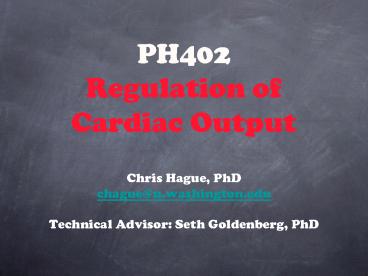PH402 Regulation of Cardiac Output - PowerPoint PPT Presentation
1 / 27
Title:
PH402 Regulation of Cardiac Output
Description:
http://www.colorado.edu/kines/Class/IPHY3430-200/09cardio.html ... the blood it receives without allowing excessing damming of blood in the veins' ... – PowerPoint PPT presentation
Number of Views:110
Avg rating:3.0/5.0
Title: PH402 Regulation of Cardiac Output
1
PH402 Regulation of Cardiac Output
- Chris Hague, PhD
- chague_at_u.washington.edu
- Technical Advisor Seth Goldenberg, PhD
2
References
- Brodys Human Pharmacology, 4th Edition
- Guyton Human Physiology
- http//www.colorado.edu/kines/Class/IPHY3430-200/0
9cardio.html - http//www.edcenter.sdsu.edu/cso/paper.html
3
Outline
- 1. Function and Anatomy of the Heart
- 2. Cardiac Output, Afterload and Preload
- 3. Excitation-contraction coupling
- 4. Frank-Starling and Venous Return
- 5. Autonomic Regulation of Cardiac Output
4
Role of the Heart
- pumps blood around the body
- left heart pumps oxygenated blood
- right heart pumps deoxygenated blood
5
Anatomy of the Heart
Pulmonary Valve
Right Atrium
Left Atrium
Mitral Valve
Tricuspid Valve
Aortic Valve
Right Ventricle
Left Ventricle
6
The Cardiac Cycle
- events that occur from beginning of one heartbeat
to beginning of next heartbeat - consists of 2 periods
- Diastole relaxation, heart fills with blood (BP
80 mm Hg) - Systole contraction, blood is ejected (BP 120
mm Hg)
7
Diastole
- venous filling of atria, A-V valve opens
- 75 flow-through to ventricles
- Atrial Priming 25 increase in ventricular
filling - A-V valve closes
8
Systole
- ventricular filling, increased pressure
- isometric contraction aortic/pulmonary valve
opens - period of ejection 70 fast,
30 slow - ventricular relaxation
- aortic/pulmonary valves close
9
What is Cardiac Output?
Cardiac output Stroke Volume X Heart Rate
OR
CO SV x HR
- Stroke Volume blood volume ejected by
ventricles/beat - Heart Rate heart beats/min
10
Preload/Afterload
- determinants of stroke volume
- Preload
- tension on ventricular muscle before contraction
- determined by left ventricular end diastolic
volume - Afterload
- pressure against which ventricles pump blood
- determined by total peripheral resistance
11
Excitation-Contraction Coupling
- generation of rhythmical electrical impulses
- sinus (or sinoatrial) node
- propagation of impulses throughout the heart
- internodal pathways
- A-V node
- A-V bundle
- Purkinje fibers
12
Generation of cardiac rhythmicity
- Sinus node
- small specialized muscle in right atrium
- controls heart rate
- spontaneous action potential
13
Cardiac Electrophysiology
Na
Ca2
Na
Ca2
K
K
14
Ion channel conformational states
- 3 states
- resting closed, can be opened
- activated open and ions moving
- inactivated closed and can not be opened
15
Spontaneous Action Potentials
- 2 ion channels regulate rhythmicity
- slow Ca channels phase O
- K channels phase 3
- membrane leakiness phase 4
16
Transmission of Cardiac Impulses
- Internodal pathways
- spread current around atrial muscle
- A-V node
- separates atria and ventricles
- delays spread of signal to ventricles
- has spontaneous activity (ectopic pacemaker)
- Purkinje fibers
- spreads impulse around ventricles
17
Non-spontaneous Action Potential
- 3 ion channels regulate firing
- fast Na channels phases 0 1
- slow Ca channels phase 2
- K channels phases 3 4
18
Cardiomyocyte Contraction
- increased Ca2i through Ca2 channels
- Ca2 spread by transverse T-tubules
- opens ryanodine receptors on sarcoplasmic
reticulum - Ca2 induced Ca2 release
- Ca2 binds to troponin-tropomyosin
- actin-myosin filament movement
19
Factors affecting Cardiac Output
- Frank-Starling Mechanism
- Autonomic Inputs
- sympathetic nervous system
- parasympathetic nervous system
- Cardiovascular disease
20
Frank-Starling Mechanism
- venous return
- increased cardiomyocyte contractility
- increased stroke volume
within physiological limits, the heart pumps all
the blood it receives without allowing excessing
damming of blood in the veins
21
Autonomic Regulation of Cardiac Output
- Parasympathetic Nervous System
- decreases HR and SV
- dominant at rest
- Sympathetic Nervous System
- increases HR and SV
- dominant during exercise/stress
22
Autonomic Nervous Systemschematic
23
Parasympathetic Effects
- Vagal nerves release acetylcholine at SA and A-V
nodes - stimulates muscarinic receptors
- increased K channel opening
- decreased sinus node rhythm
- decreased A-V node transmission
- ventricular escape
24
Sympathetic Effects
- Sympathetic nerves release norepinephrine
throughout heart - stimulates adrenergic receptors
- increased Ca and Na channel opening
- increased SA node rhythm
- increased A-V node transmission
- increased force of atrial and ventricular
contraction
25
Baroreceptor Reflex
- rapid control of CVS function
- sensory baroreceptors in carotid sinus and aortic
arch detect BP changes - increased BP detected, increased vagal firing,
decreased CO - decreased BP detected, increased sympathetic
firing, increased CO
26
Renin-Angiotensin System
- decreased BP causes release of renin from
juxtaglomerular cells of kidney into blood - renin cleaves angiotensin to angiotensin I
- angiotensin converting enzyme (ACE) converts
Ang-I to Ang-II
- Ang-II increases plasma volume and BP, increases
CO.
27
Diseases affecting cardiac output
- atherosclerosis increased TPR, increased
afterload - coronary artery disease decreased cardiac O2
supply - congestive heart failure decreased stroke volume
- stroke
- renal disease
- diabetes































